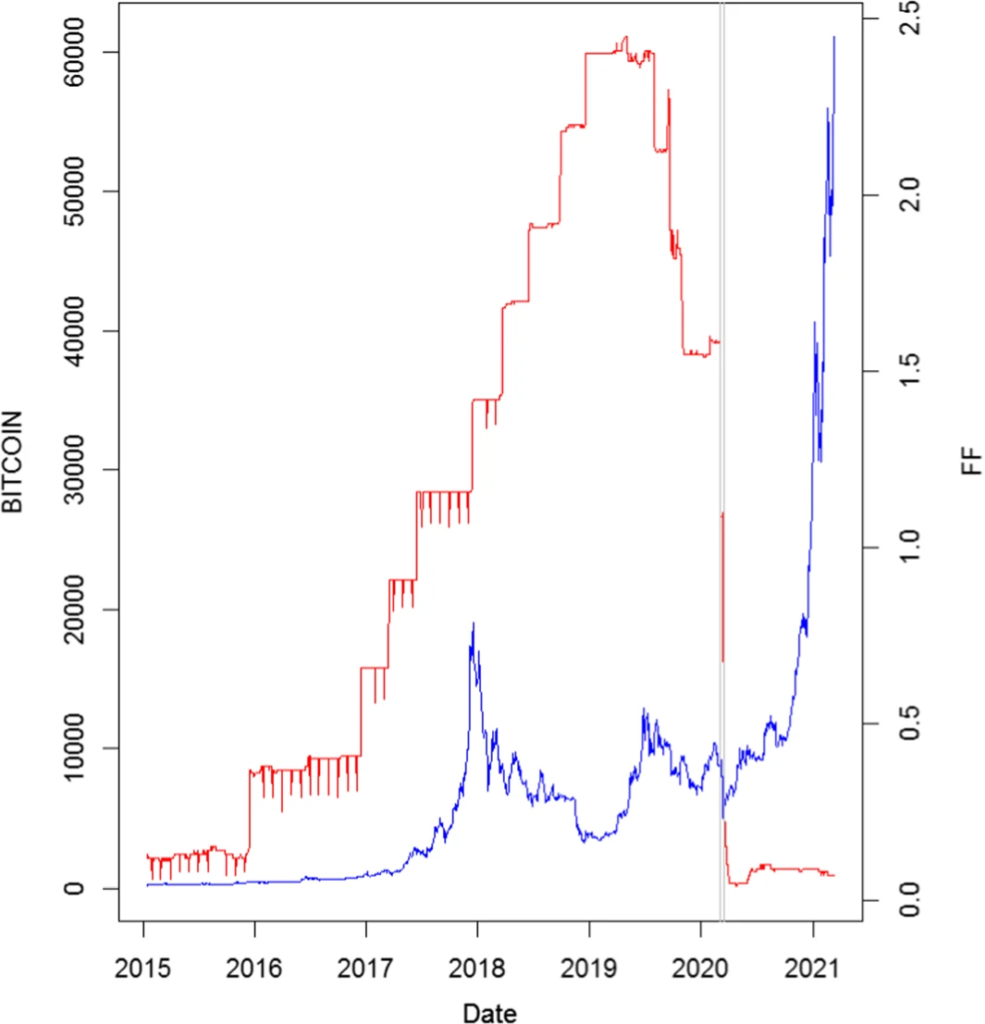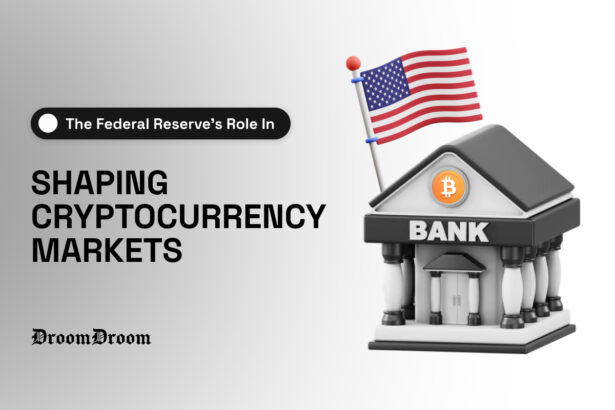Cryptocurrency markets, especially Bitcoin, have drawn global attention for their potential to transform finance.
But they don’t function in isolation. Central banks—particularly the U.S. Federal Reserve (Fed)—play a critical role in shaping these markets through their monetary policies. From interest rate shifts to influencing market sentiment, the Fed’s actions have a notable impact on how digital assets like Bitcoin are valued and traded.
Let’s explore how this relationship plays out.
The Fed and Cryptocurrency Markets
The Federal Reserve has long been a cornerstone of global financial stability, steering economic policy through interest rates and liquidity control. But how does this influence extend to a decentralized world of digital assets?
A study published in Empirical Economics analyzed Bitcoin’s price behavior in relation to the Fed Funds rate between 2015 and 2021. The findings were clear: lower interest rates boost Bitcoin’s growth. As borrowing becomes cheaper with falling rates, investors tend to seek returns in riskier assets like cryptocurrencies.

This trend was especially visible in September 2023, when the Fed reduced interest rates by 50 basis points. As the markets reacted, Bitcoin surged past $67,000. This wasn’t an isolated case; it followed a broader pattern where Bitcoin’s price has consistently aligned with the Fed’s monetary easing policies.
As the Fed reduces rates, investors pour capital into Bitcoin, chasing better returns than those offered by traditional savings accounts or bonds. It’s like searching for shade in a desert—the thirst for higher returns drives them toward cryptocurrencies.
The Impact of Fed Fund Rate Changes on Bitcoin Prices
One of the most direct ways the Fed influences Bitcoin is through rate adjustments. However, this effect is more nuanced than simple cause-and-effect. It influences investor sentiment, capital flow, and ultimately, Bitcoin’s market volatility.
Investor Behavior and Market Sentiment
When the Fed lowers rates, it’s akin to giving investors the green light to embrace risk. With cheaper borrowing options, they gravitate toward assets that promise higher returns, like Bitcoin. For example, after the September 2023 rate cut, Bitcoin experienced an immediate surge.
But the impact goes beyond actual rate cuts. The mere anticipation of a rate change can move markets. Before the September announcement, Bitcoin reached $60,000, driven by speculation that the Fed would ease rates. Think of it as playing poker—sometimes, even a bluff can force your opponent’s hand. In this case, the Fed’s “bluff” shaped cryptocurrency market behavior well before the official announcement.
Nonlinear Effects and Time Lags
The relationship between Fed policy and Bitcoin prices isn’t always straightforward. Researchers have observed nonlinear effects, where small rate adjustments have minimal impact, but larger cuts can trigger significant price movements. Moreover, it’s not just the size of the cut that matters—sometimes, the market takes its time to react. The lag between a policy change and its effect on Bitcoin prices can be days, even weeks.
It’s like tossing a stone into a pond: the bigger the stone (or rate cut), the more pronounced the waves, but those waves don’t always reach the shore right away.
How the Fed Shapers Crypto Market Reactions
When the Federal Reserve makes a major announcement, its effects extend beyond traditional assets. Cryptocurrency markets, particularly Bitcoin, are highly sensitive to these moves. The concept of spillover effects—when volatility in one market impacts another—is especially evident here.
For example, research shows that U.S. monetary policy announcements have a direct impact on Bitcoin’s volatility. When the Fed makes bold policy shifts, it can send cryptocurrency markets into a whirlwind, leading to substantial price swings.
These announcements often create uncertainty, sparking short-term sell-offs followed by rebounds. It’s like a roller coaster—exciting for those with the stomach for it, but dizzying for those who prefer stability.
Risk-Off Sentiment
Interestingly, these effects aren’t always positive. After recent rate cuts, initial optimism often gave way to corrections, as investors reconsidered the broader economic picture. This is a classic case of risk-off sentiment, where caution sets in after an initial surge, leading to temporary pullbacks in the crypto space.
This highlights how sensitive Bitcoin and other cryptocurrencies are to external economic factors, challenging the notion that they operate entirely independently from traditional finance.
The Role of Regulatory Clarity in Shaping Crypto Markets
The Fed’s role in cryptocurrency extends beyond monetary policy. Regulatory clarity plays a pivotal role in shaping investor confidence and determining the overall market direction. As governments and institutions work to establish clear crypto regulations, market stability increases, giving Bitcoin more room to grow.
On the international front, Europe’s MiCA regulations offer another example of how clearer rules can boost investor confidence.
When regulations are well-defined, institutional investors feel more secure entering the market, bringing significant capital and credibility with them. It’s like building bridges rather than walls—clear pathways invite more participants into the crypto space.
Bitcoin as a Store of Value Amid Global Rate Cuts
As central banks around the world continue to lower interest rates, Bitcoin’s appeal as a store of value strengthens. Think about it: when cash yields little return in savings accounts, investors seek alternatives that can preserve, or even grow, their wealth.
During periods of expansive monetary policy, when central banks print more money to stimulate the economy, concerns about inflation rise. In this context, Bitcoin shines as a hedge against inflation. It’s like gold but digital—a modern asset that protects against the devaluation of traditional currencies.
Interest rate cuts, not only in the U.S. but across the globe, contribute to Bitcoin’s allure. As fiat currency loses purchasing power, investors look for refuge in assets like Bitcoin that have a limited supply. This is why, during periods of quantitative easing and similar monetary expansions, Bitcoin often experiences increased demand.
Experts across the financial spectrum agree that the Fed’s decisions will continue to shape the future of cryptocurrencies. Dan Raju from Tradier notes that with each rate cut, cryptocurrencies become more attractive to investors seeking alternatives to traditional finance.
Analysts are also forecasting that Bitcoin’s bullish trend may persist as the Fed continues to ease monetary policy. But as the saying goes, “Don’t count your chickens before they hatch.” While Bitcoin has the potential for further growth, its volatile nature means that nothing is guaranteed.
Conclusion
The Federal Reserve’s influence is clear. Through its interest rate decisions, policy signals, and impact on the broader regulatory environment, the Fed plays a central role in shaping the market in which Bitcoin and other digital assets operate. As we move forward, staying attuned to central bank policies will be crucial to understanding where crypto markets are headed.
The interplay between traditional finance and decentralized currencies is complex, but one thing remains certain: the Federal Reserve’s impact on cryptocurrency markets will persist.




















